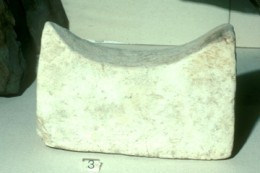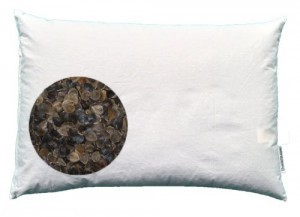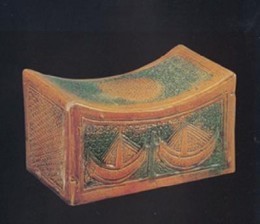History of the Pillow, Not always a softie.
History of the pillow? Come on, if you’re like me you love these tidbits of random information based on fact or whatever I can Google from Wikipedia.
Now, for the men reading this, at no time will we be heading off on a side tangent covering pillow fighting and scantily clad women, sorry but no.
Let us start at the beginning, the time about 7000 BCE in the ancient civilization of Mesopotamia, what you all know now as Iraq. Now picturing fluffy rectangles of comfort? Well don’t, they introduced the pillow in the classic stone variety. I’ve included an uncomfortable photo below:
 Thank you http://hubpages.com/hub/The-History-of-the-Pillow# for exhibit #3.
Thank you http://hubpages.com/hub/The-History-of-the-Pillow# for exhibit #3.
These ancient pillows were not at all like our pillows today, (that’s funny, I often sleep on the cold hard abs of book models and call them pillows, not!) They were hard (THE PILLOWS! Just get your minds out of the gutter, there’s only so much room in here) -usually made of stone, as is the one in the above picture, which was found on an archaeological dig in Egypt.
More often than not, the ancient Egyptians propped their necks up on these stone pillars as a way to keep bugs from crawling into their ears, mouths, and noses. (EEEEWWWW!)
The Chinese Perfected the Hard Pillow
The ancient Chinese also used pillows constructed of stone or wood, but they always decorated them somehow. Asian cultures believed that soft pillows actually stole energy from your body while you slept (probably ancient trolls that stole your breath away like in Stephen King’s movie Cat’s Eye!).
But the Chinese even began making pillows out of ceramics sometime before the sixth century AD, as you can see in the picture above. Beautiful, but oh-so-uncomfortable-looking.
The Japanese geisha used a similar hard pillow to balance their necks on at night so they wouldn’t mess up their hair. Seriously, I’ve always said that Beauty is a rough gig. No pain, no gain…or was that working out? Anyhoo, they didn’t want their hair to get messed up while they slept. I guess it must have taken them a really long time to fix their hair, and they didn’t want to have to do it every day. (maybe I need one of these pillows)
 Now, most of Japan have given up the hard pillows in favor of all-natural buckwheat pillows. Buckwheat hulls are a great pillow stuffer because they conform to the shape of your head and neck and provide the best support possible for this delicate area of the body. Not sure what they do to your hair, though. I’m sure the hairstyles are much more relaxed.
Now, most of Japan have given up the hard pillows in favor of all-natural buckwheat pillows. Buckwheat hulls are a great pillow stuffer because they conform to the shape of your head and neck and provide the best support possible for this delicate area of the body. Not sure what they do to your hair, though. I’m sure the hairstyles are much more relaxed.
But not everyone in Ancient history liked them hard… Pillows people!
The ancient Greeks and Romans used pillows that were more similar to what use today. When we hear the word “pillow”, I think of fluffy clouds of goodness, don’t you? These pillows were made of cloth and stuffed with feathers, reeds, or straw. They were often embroidered, and great prestige was given to the highly skilled pillow maker/decorator. (All Hail the interior designer!)
Then the Pillow Fell Out of Favor
In Europe during the Middle Ages, many people did not use a pillow at all. Pillows became status symbols and were mostly reserved for the upper classes. In fact, when Henry VIII was king of England, he banned the use of pillows by anyone except pregnant women (and himself, I think). Most men didn’t want to use pillows anyway because pillow use was seen as a sign of weakness. (Apparently I would need to remain pregnant and weak throughout the middle ages… I MUST have my pillows!)
And Then the Industrial Revolution Hit
Mass pillow production commenced by textile companies in the United States and Europe. Suddenly, everyone had pillows on their bed at night and even had decorative pillows on their couches and chairs. These were very similar to the ones we use today. (Although I doubt they cost $100 a pop like some do now.)
The History of the Pillow Is Not Yet Complete
Manufacturers continue to make improvements on the standard pillow. Bed pillows now come in a range of firmnesses and sizes. There are even special contour and memory foam pillows that are designed to adjust to the weight of your head to give you custom head and neck support, no matter what position you sleep in.Now back to the neck pillow? It’s the same idea the ancients had – support the head by supporting the neck – but it’s a lot more comfortable. Thank goodness neck pillows today aren’t made out of stone. Sometimes change is good, In the words of Martha Stewart; “it’s a good thing”.A little history and a bit of fun. I can hear my 3 pillows calling me now… Sweet & Fluffy dreams my friends.
 Ooops, how did that get there… Sweet dreams!
Ooops, how did that get there… Sweet dreams!
Special thanks to http://hubpages.com/ where I acquired most of my facts and wikipedia.
The post History of the Pillow, Not always a softie. appeared first on Pillow Talk Blog.




